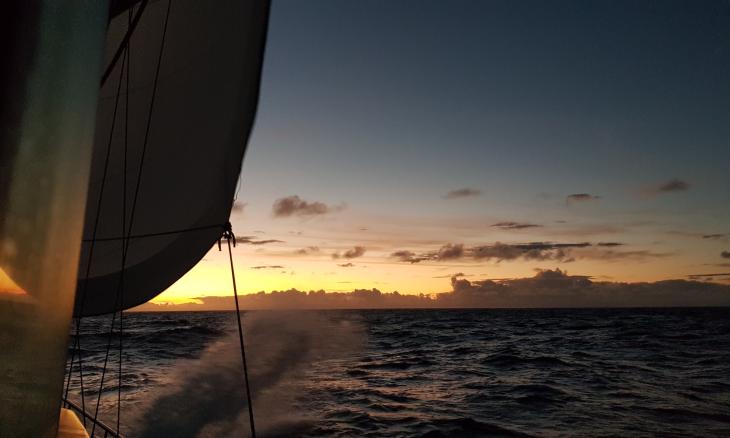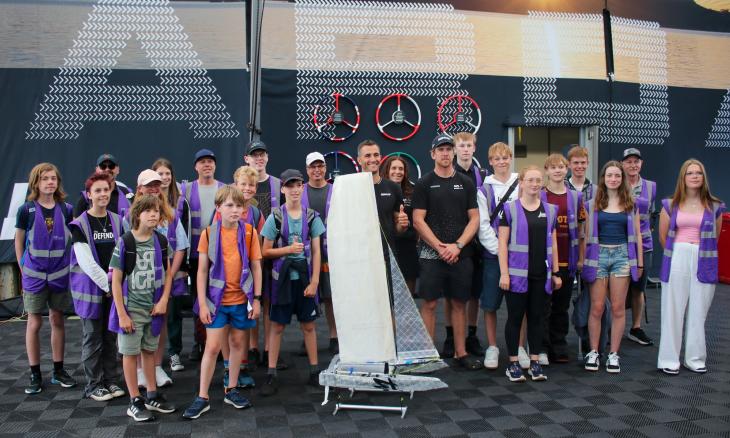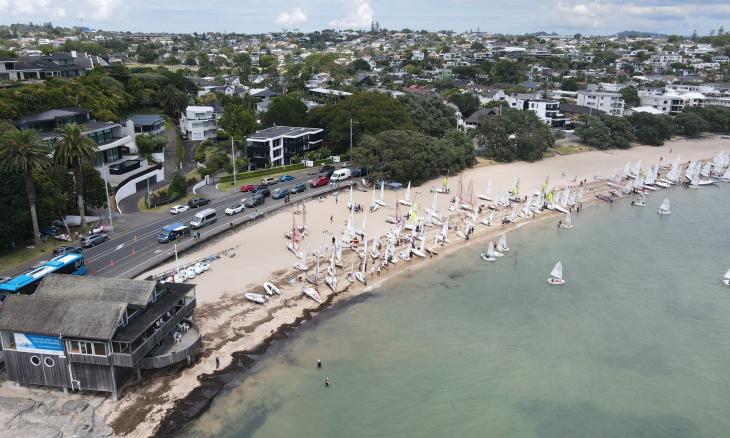Hello sailors, I trust that you've all braved the cold water and got out there to show the dinghy sailors how useful a keel can be in spring conditions. We certainly appreciated it on Fflypast last weekend in a challenging southwesterly for the Nelson Marlborough regional champs. Don’t worry, by the time the Nats arrive we will have settled into the sunny Nelson summer sea breeze pattern.
A number of past F15 sailors have emailed in response to the 50th Nationals Prize Giving Reunion Dinner and they include;
- Barry and June Finlayson
- Paul and Pat Pritchett
- Andrew and Kate Morrison and,
- Tup and Gillian Radford
Andrew Morrison’s background in F15s started in 1971. Andrew represented NZ in numerous world contests from 1982 to 1999, was National President for a number of years, and was responsible for the importation and construction of the competitive ‘Windebank’ designs in 1987 and thereafter.
Tup Radford sailed three F15s, Seagoon, Saffron and Fflagship, for 42 years at the Evans Bay Club and was National President, but says it was so long ago that he can't remember when!
If there’s anyone else out there who would like to share some history or stories with the new generation of sailors, please do email me or even better, join us in Nelson for the 50th Nationals Prize Giving Reunion Dinner!
Festival of Fifteens Results
Competitors from Whangarei and the BOIC battled it out over seven races of the Festival of Fifteens on 10 & 11 Nov. Six races were simple windward-leeward laps, and one bay race which took them to Brampton Buoy, Russell and up and down Veronica Channel. Rob Ward and Bruce Yovich sailed Fflying Colours (photo) to a convincing win. On the handicapping system, Pingan Ffaitour showed the most improvement with Patrick on the helm and John Roberts crewing. Saturday the Bay of Islands put on its very best sailing weather with moderate steady sea breezes and brilliant sunshine. Sunday morning saw the fleet battling with light airs, but after lunch a good Nor-wester settled in. Thanks go to the competitors and volunteers supporting this wonderful event! For more details, please have a look at the club website www.boiyachtclub.co.nz.
Some great photos from the Festival of Fifteens can be found on the NZ Flying Fifteen Facebook page here
50th Flying Fifteen New Zealand National Championship
Regatta dates are:
Invitation race – 2 February
50th F15 NZL National Championship and Worlds Selection Regatta – 3,4 & 5 February
Hosted by the Nelson Yacht Club
Notice of Race and Entry Form can be found here. Entries by 15 Jan, a late entry fee will apply after that.
Reunion Prize Giving Dinner
Current and past sailors and friends are invited to celebrate with 50th National Champions at a reunion dinner that will be held with the Prize Giving on 5 February 2013 at the Nelson Yacht Club. The meal will be catered by Relish Restaurant. The cost of the meal will be $45 per person for non-competitors. Competitor meals are included in the regatta entry fee.
Spectator Boat
If you are not competing there will be an opportunity to view the racing from a spectator boat.
R.S.V.P.
Please RSVP your expression of interest for the reunion Prize Giving Dinner and Spectator boat to class secretary Sandra Williams sandraff15@gmail.com, 03 548 0879 as soon as possible or before 31 December 2012 to assist with organisation.
Boat Transportation
If you are coming from the North Island, contact Craig Coulam from the Auckland Fleet, who will be able to fill you in on arrangements for shipping AKL – NSN – AKL approx. 3rd week Jan.
Check out places to stay at www.nelsonnz.com/accommodation, www.bookabach.co.nz, www.holidayhomes.co.nz or www.holidayhouses.co.nz
For more information contact Sandra Williams (sails Fflypast 3838) or John Leydon or check www.flying15.org.nz.
Changes of ownership
Chris Field has purchased Flying Cloud 3740 from Barrie Campbell and Welcome to Stephan who has purchased FFatLady / Revival 3085 from Zane.
Sail Development Plan
At the FFI Meeting at the Hayling Island Worlds NZ was asked to provide some feedback on the development sails. We asked John Leydon of Doyle Sailsand F15 sailor to prepare something, here’s his story...
About 2008 FFI approached BIFFA and subsidised them to research and come up with a ‘more modern’ sail plan for the Flying Fifteen. The reasons had to have been mainly marketing, to project the image of the class as a contemporary race boat. The guidelines were for sails of similar area to the current ones, so as not to increase the speed of the boat, but taking advantage of the visual and technical advances in sailcloth and sail design, to produce higher aspect sails , and with a bigger roach on the main to enable lighter crews to handle the boat better in the breeze.
There are a number of new double handed classes, particularly in the UK, keelboats like the Laser SB3, RS Elite, and now the VX one design (by our own former FF champion Brian Bennett), and a huge range of trapeze and non trapeze gennaker powered centerboarders from RS, Topper, Laser and others, all of which are seen as competing for bodies against the Flying Fifteen.
Most of the traditional British dinghy classes have converted to fibreglass construction, and even the Mirror Dinghy, after 70000 boats had been built, changed from its wooden gunter rig to an alloy sloop rig in 2006 to attract Optimist and Cadet sailors who had never seen wooden spars. They did retain the red sails of course, their point of difference.
FFI considered that in this marketing battle the low aspect white sail plan of the FF dated it against the opposition, and as the hull will always be the same, the sails would be the easiest thing to change.
The guidelines were given to Batt, Goacher and Pinnell and Bax sailmakers, and the 3 lofts produced basically fairly similar sails .The Batt sail had a larger head, reflecting OK experience, but the other 2 produced mainsails within 50mm about the top batten width.
The jib has had the luff extended and the foot shortened to keep the area similar, The original sailplan for the boat had the jib tack 9 inches above the deck to allow for visibility and sheeting, and the proposed head is in about the same place. Interestingly, the jibs were all made of Dacron so they could be furled without damaging the fabric.
The mainsails are about 200mm shorter on the foot, same luff, and have a straighter leech, going up to moderately wide head, with an extra batten to support the additional area. The sails to date have ben laminated polyester (Dimension /Polyant Flex) crosscut, to keep the cost down. This construction is the same as most current Dacron sails, but using Kevlar or Carbon laminates and radial construction will double the cost of the materials and increase the labour component. And of course, while the racing life will be a couple of regattas, the sails won’t be as good or as useful as a 2 contest Dacron sail for club racing. Dacron could also be used with the new sailplan.
At the 2009 Nationals the NZFFA agreed to support the trials of the new sail plan, as there was expectation that somewhere down the line a new sail plan would be introduced. At the British Nationals that year, in which Sandra Williams and I competed, the Goacher and P&B sails were available for use, and we were asked to trial the Goachers. This was after day one when we were both non-British and well down the results, and no one had picked up we had reconfigured the borrowed boat for P&Bs. After the next day when we had come up the fleet a bit, the sails were set up on 2 other boats! This involved dropping in a new jib halyard, and presuming the mast bend settings were close enough. Did you know it is possible to climb to the hounds of an FF mast when the boat is on the trailer? Results were not spectacular. But both boats reported remarkable speed reaching, but both were finishing well back, probably where they had been anyway. When the mains were laid out on the floor the luff rounds were close, and the roach profile was very similar, the position of the top batten being slightly different. The Batt sails did not appear.
The English fleet had held a weekend 6 months prior to the nationals when a number of boats gathered at a pond and had a few races so that people could jump in boats that had been set up with the new sails, and race against the regular rigs. About 10 crews too part and the resultant survey did not show a lot of enthusiasm for the new sail plan. Check out the UK Flying Fifteen Bog for comments http://flyingfifteen.wordpress.com/.
Remember that no one has spent any time with these sails, whereas everyone has plenty of experience with the current sails, and the top sailors know how to use them in all conditions.
Next move in New Zealand was that FFNZ bought a set of the sails from Steve Goacher. These are the MK2 design. Aaron Goodmanson and Alastair Rowlands used the mainsail on Day3 at the 2010 nationals and Goody thought it was OK, they still won! Remember that Goachers use no prebend, and ‘Fortune ‘ was set up for Doyles, with major prebend. Also, bear in mind that the idea of the sails was to help the lighter crews!
The next crew to try the sails were Craig Coulam and Adrienne Reike on ‘Blowfish’. On a light day they tried the main only in a club race and went OK but then, in those conditions, they do anyway.
The last crew to try the sails were John Leydon and Sandra Williams on ‘FFlypast’ at the Nelson Marlborough champs on November 2010. The seabreeze was 15-18 knots all weekend and I felt it was a good test for the sails. We liked them. Sandra found the jib was easier to pull in, a common comment from crews who had used them. We just let the mast ram go and the rig looked like a Star class, huge bend, flat main, head open but not falling away, and the boom in the centre. In these conditions the boom would usually be half a metre out. The boat felt great, and we were easily the fastest FF in the regatta, which is a bit misleading as we were probably the only FF on the water south of Waitangi that weekend. But we left a 3.7 behind on the wind, so if you know how you go against a badly sailed 3.7, it may give you some idea.
I thought the design of both sails was saleable, Steve Goacher seemed to have it pretty right. Only negative was that we had noticed in Wales that while the large windows make visibility better when using the sail, the grey sail is a lot harder to see when you are sailing against it. There will be a few more dinged gunwhales coming up!
Since that weekend the sails have had little use, a shrewd investment by FFNZ .The sun degrades the mylar film, and they will last longer under Craig’s bed.
In another development, the following week we sailed with a flying Dutchman main. This was about 400mm shorter on the foot, and was a tad long on the luff as we had the Cunningham hard down and the boom almost on the aft deck. It was hard to tack, but really comfortable for our 24 stone on the wind. I then built a sail off the Doyle Goody pattern, with a short foot ,much reduced luff round, and over 10 knots we are very comfortable to windward and no slower down wind. It is maximum at the top quarter height and quite straight from there to the clew. The area at the top blades out, and having less roach down low feels good. Won’t mention the small kite at this stage, but wait till they bring back reaches!
Goody has already asked what the class is doing to help heavy crews, and it is possible that as many of the top combinations are around 30 stone there is little incentive to change everything to make life easier for the lightweights. Could it be that the Alto mast is going to level the playing field a little bit more and reduce the urgency to change the sails? Watch this space
So, the full circle has been achieved. Unnofficial talk at the last Worlds was that dacron will have to be reconsidered because the class will baulk at having to buy new sails every season. The original test sails have not lasted well. It appears to be a dead duck also because no one has come up with a method of introducing the new sail plan. It is agreed that the new and old should not race against each other which means the whole fleet will have to convert between 2 world championships. It is expected a lot of slower boats will not do so, and will disappear, never to return. There was talk of only changing the jib. This would be easy to do as most boats get a new jib every couple of years and the new design works well, and changes the appearance of the boat noticeably. It will be an aid to crews as well. Two boats at the Worlds had double purchase on their jib sheets for small forward hands.
Australia has ignored the whole programme at this stage, One reason is that BIFFA has not given the guidelines out so local sailmakers in other countries can have a go. Obviously if the sail plan changes it is a bit more even for all sailmakers with an interest in the class to develop a sail to the new rules, but I think the Goacher set NZ owns are pretty close, and Steve offered unofficially to send his design file to Australia for them to make a set. With the high Aussie dollar it would be cheaper for them to buy their sails in the UK. Or from here. (Since writing this, Steve Goacher has won the 50th Australian FF Nationals and has broken the stranglehold P&B sails have had forever on winning that event. Presumably there was some discussion at that contest about the new sails,as Alan Bax was second).
Where to from here? Nowhere probably. The fact that the Dacron sails last a lot longer that laminated ones is taking the ‘modern’ fabric out of the equation, and the modern profiles are not thought to be a big attraction to those already in the class. Even our younger teammates said they were attracted to the class because of the One Design, traditional appearance, and surprisingly good performance.
Existing class members are not talking about leaving the class because it is old fashioned, but this is preaching to the converted. Research needs to be done on people outside the class to see whether the ‘traditional rig’ is a factor in them not joining the class, or is it some other reason. Greg Wells (President FFI) has had a marketing exercise done on the class in general, and the rig is a small part of that.
Bear in mind that this whole issue is mainly confined to Britain, where lots of people are buying lots of boats and the Flying Fifteen is one of many options. No other country has joined the discussion yet. Either the Poms are overthinking this, or in raising it they are pointing to problems we have yet to face, and we should be considering what we have achieved in the attempt to not only raise the profile of the FF in NZ, and attract more people to the class, but also to get the existing boats on the water more frequently
After the Hayling Island Worlds Sandra and I crewed in an X One Design (XOD) for Cowes Week. The X boat is a 6m 11/2 ton open ballasted keelboat a bit like a miniature H28.The class was celebrating its centennial and of the 210 boats built in the last 100 years, 145 were on the starting line. They are currently thinking of going to alloy masts as the wooden ones cost so much to replace. They are also talking about strip plank or coldmoulded hulls as carvel construction is very expensive, and a dying art.
And you thought the Flying Fifteen had problems…..
Happy Sailing everyone, look forward to seeing you at the Nats.
Sandra Williams
Fflypast 3838



